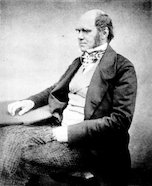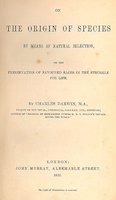Charles Darwin

Key dates
- 12 February 1808—Birth date
- 27 December 1831—HMS Beagle leaves Plymouth
- 15 September 1835—Galapagos Islands sited
- 2 October 1836—HMS Beagle arrives home
- 20 June 1837—Journal of Researches completed
- 22 November 1959—Origin of Species on sale to the public
- 19 April 1882—Died
- 26 April 1882—Buried in Westminster Abbey
Key facts
- English Naturalist who demonstrated that all species devolve from common ancestors
- Studied medicine at Edinburgh and Theology at Cambridge
- Became an eminent geologist after his voyage on the Beagle
- His theory of natural selection began with his interest in the different finches on the Galapagos Islands. Each Island had its own form of finch, related but different in important ways.
- Other scientific projects included work on plants and the study of the earthworm.
- Published works include: Origin of Species, The Descent of Man, The Expressions of Emotion in Man and Animals, The Power of Movement in Plants, and Formation of Vegetable Mould Through the Action of Worms.
- He was married to his cousin, Emma Wedgwood and had ten children.
- Buried next to Sir John Herschel and not Isaac Newton as often thought.

Scholastic Education PLUS resources
Scholastic teaching resources
Events
- The Great Plant Hunt. In March 2009, every primary school in the UK will be sent a Darwin Treasure Chest. It will be packed with resources enabling the children to do real science inside and outside the classroom by exploring habitats, growing plants and collecting seeds.
- Darwin’s Footsteps is an online interactive game, developed by a primary school in Bolton, aimed at children aged 7–11 years. Follow the journey of Charles Darwin around the world with a series of mini-challenges and information about his discoveries. Teachers’ notes are also available.
- Evolution Megalab is a Europe-wide, mass experiment run by the Open University and Royal Society asking people to record observations online about banded snails in gardens or in parks. Primary schools’ resources will be developed for 2009.
- See the Natural History Museum’s programme for schools to find out about the Charles Darwin gallery character, Annie Darwin puppet workshops and performances of How the Giraffe got its neck.
- Explore the Natural History Museum’s Evolution web pages for a summary of evolutionary theory,
- Darwin-inspired learning and teaching is a framework for education inspired by Darwin developed by the Charles Darwin Trust. They are producing resources for students and teachers for early 2009 including a website, Darwin’s Study, in collaboration with the Science Learning Centre and the Natural History Museum

Links
Published 19 January 2009